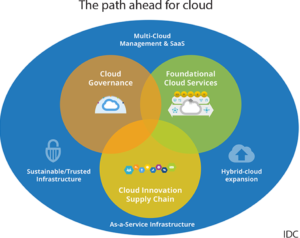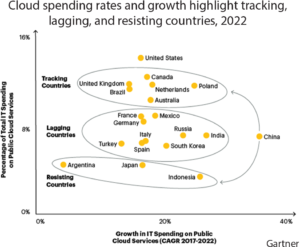Cloud
Cloud set to explode in 2022

Cloud computing is the new wave – now more than ever during a crisis. With business outcomes increasingly tied to the ability to develop and use innovative technologies and services anywhere, cloud is proving to be the foundation for meeting this need.
The situation derived from the Covid-19 pandemic, as in most aspects of life, has proved to be an accelerant for some trends that were already identified, of some activities that were already underway. It is also a differentiator for those that are and are not advanced in their adoption of the key technologies. Cloud computing is playing an increasing role in ensuring the smooth provision of services, and this has been demonstrated throughout the pandemic, also enabling the opportunity to provide additional new services in simple, cost-efficient manner.
Cloud computing and cloud storage are all but essential for businesses looking to make the most out of the abundance of data being produced today. They are also useful for businesses that want to upgrade their capabilities without needing to spend millions on hardware upgrades that will soon need to be replaced. Not only does cloud computing offer the flexibility that companies need to adjust to fluctuating business environments, it eliminates the high cost of hardware, IT resources and maintaining internal and on-premise data systems, gives the companies the ability to deploy and launch programs and applications quickly and seamlessly. All of this might explain why cloud adoption is growing and is projected to keep growing into the future.
In financial services, firms have undertaken a transition to new models of work, and sometimes face an unpredictable increase in workloads. Cloud has played an important role in managing this, from the day-to-day transitioning from physical to remote environments, to managing volatile spikes in service demands.
For some firms, cloud architecture has represented a key element to effectively manage the new scenario, supporting a resilient infrastructure in the context of the otherwise limited bandwidth of traditional architectures. The elasticity and scalability characteristics of public cloud, in addition to the ability of cloud workloads to be available via the public internet on an any time any place basis, and beyond other clear and demonstrated benefits, have made this a powerful tool for firms using public cloud in responding to such a global and disruptive environment. This acquires special relevance in the provision of financial services, in many cases considered essential.
Covid-19 has shown the limitations of legacy applications and infrastructure in their ability to support both the immediate shift to primarily digital engagement with consumers and the extraordinary volumes and volatility that are challenging global markets.
Key applications must provide continuous service, in the face of events, such as this global health crisis, hardware failures, and human errors. Outages create risks of application downtime and data loss, resulting in revenue loss, legal and financial implications, impacts to reputation (trust), and customer dissatisfaction. The added versatility of cloud delivers new ways to mitigate risk and build resilience against outages, supporting financial stability.

Among its many benefits, cloud computing architecture can help to ensure that financial institutions and the critical functions they perform are resilient to disruption (keep their level of availability), whatever the cause. Cloud is an important component for continuity of operations and efficient failover in times of crisis and operational disruption, and is increasingly part of the architecture for overcoming these challenges and ensuring comprehensive execution.
Since 2010, the global cloud services industry has risen year-over-year (YoY) to reach a USD 370-billion valuation in 2020, marking a growth of over 380 percent in ten short years. At the end of 2020, the virtual weight of all the information in the world was 44 zettabytes (trillion gigabytes). And, around 50 percent of all corporate data is stored in the cloud, as of 2020. Entire industries want to intelligently leverage data to their advantage and can do so because they have faster access to digital technologies built on a cloud foundation.
Given its central role in the future enterprise, IDC forecasts whole-cloud spending, total worldwide spending on cloud services, the hardware and software components underpinning the cloud supply chain, and the professional/managed services opportunities around cloud services will surpass USD 1.3 trillion by 2025, while sustaining a compound annual growth rate (CAGR) of 16.9 percent. IDC’s forecast looks at both shared (public) cloud services and dedicated (private) cloud services.
Shared (public) Cloud-as-a-Service, those shared among unrelated enterprises and/or consumers, open to a largely unrestricted universe of potential users, and designed for a market, not a single enterprise for infrastructure, platforms, and various software offerings continues to be the largest, and fastest increasing, engine of growth for the whole-cloud market. Combined spending on shared cloud services – Infrastructure-as-a-Service (IaaS), System-Infrastructure-Software-as-a-Service (SISaaS), Platform-as-a-Service (PaaS), and Software-as-a-Service (SaaS) – will total USD 385 billion in 2021, and will see a CAGR of over 21.0 percent through 2025, reaching USD 809 billion.
Dedicated (private) cloud services, delivered as subscriptions or managed service agreements provided by cloud, colocation, outsourcing, or managed service providers to their enterprise customers, include hosted private cloud services and the fast-emerging Dedicated-Cloud-Infrastructure-as-a-Service (DCIaaS) segment, will grow at a faster CAGR of 31.0 percent, but from a much smaller revenue base of USD 5 billion in 2021.
The as-a-service segments of cloud spending, combining Shared-Cloud-as-a-Service and Dedicated-Cloud-as-a-Service, will account for the majority of all cloud spending throughout the forecast, growing from 55.7 percent in 2021 to 64.1 percent in 2025. These segments will also see the fastest growth in spending, with a five-year CAGR of 21.3 percent.
Cloud buildout – the hardware, software, and standard support services for these cloud assets – represents the most critical area of cloud spending outside the as-a-service segments. IDC has already established that spending on compute and storage infrastructure products for cloud infrastructure will continue to outpace non-cloud IT infrastructure investments throughout its forecast. The five-year CAGR for cloud hardware, software, and support is expected to be 11.8 percent.
The two remaining segments of cloud spending that are not part of the as-a-service total are cloud-related professional services and managed cloud services. Cloud-related professional services encompass a range of project-based services, such as strategic planning, assistance in implementation or adoption of all types of cloud services, and other projects that require a cloud-delivery capability as a foundational element. Managed cloud services are the provision of management capabilities to ensure 24×7 operations of cloud technologies and architectures, both applications and infrastructure, and associated business processes and embedded professional services. Cloud-related professional services and managed cloud services will see similar levels of spending throughout the forecast, with managed cloud services experiencing faster spending growth over the course of the forecast.

Moving forward, the fundamentals driving the cloud market will continue to shift with the transition to a digital-first economy. For cloud service providers (both shared and dedicated), the focus will be on defining the types and scale of resources delivered, governing the movement, storage, and analysis of data, and establishing robust developer, security, and subject-matter ecosystems. For cloud infrastructure providers, the development and deployment of specialized capabilities across diverse environments will become more important than extending the breadth of generalized solutions. And for IT organizations, the governance of diverse cloud resources and data sets will pose critical operational challenges.
With enterprises focusing more on outcomes in their cloud-selection processes, the long-term focus for all cloud providers will be on strengthening their relationships with business, not IT, from device, to edge, to network, to core.
Cloud is playing an ever-greater role across the IT industry, as we all pivot to competing in a digital-first world. Companies, governments, and consumer are demanding digital-based capabilities and enhancements that improve lives and achieve desired outcomes. Entire industries want to intelligently use data to their advantage. Both are possible because cloud provides the foundation for faster access to digital infrastructure and platform technologies.
In this second act, cloud (in all its permutations) will play an ever greater, and even dominant, role in shaping the IT industry. All IT vendors, developers, and providers will focus on delivering greater efficiency, more flexibility, and faster innovation. It is expected that:
Suppliers in the cloud technology supply chain (silicon, systems, facilities, and core software) will add as-a-service infrastructure as a standard digital infrastructure option. Enterprises will depend upon suppliers to deliver rapid access to new technologies at scale, so they can develop and deploy new, more specialized, and more trusted innovations across diverse environments from edge, to network, to core.
The assessment, management, optimization, and securing of diverse cloud resources (and data) will pose the most critical operational challenges for IT organizations. They will require cloud governance SaaS, and managed cloud services, that use embedded AI to make automation more effective, while also enabling consistent governance across multiple cloud environments.
Cloud service providers have deep insights into changing workload mixes across industries. Whether you are a SaaS provider or an enterprise engaged in digital transformation, your developers depend upon providers of foundational cloud services (FCS) to anticipate and accelerate the pace of digital innovation.
The major cloud providers have global infrastructure with distribution of data centers across zones and regions (with zones physically separated and isolated to effectively avoid contagion risk) to prevent single point of failure.
Data or other operations can be replicated across regions, without compromising the level of service enabling redundancy, without impact on latency. In addition to that, dependencies and calling patterns between regions are asynchronous and ring-fenced with safety mechanisms, allowing redundancy configurations at a scale and economy that were not previously possible.
Elasticity is the key feature of cloud architecture that allows firms to adapt to market conditions very rapidly and efficiently. In a Covid situation, the most relevant benefit of this is the ability to scale up automatically without physical on-site presence, adding servers to process peaks to minimize service disruption or outage. Scalability has been critical in many different ways.
Cloud computing might seem like a miracle solution, but on-boarding cloud computing companies face many challenges.
Cloud security is an immensely important consideration that needs to be made by companies looking to adopt remote computing. Cloud computing comes with a unique set of security risks. Perhaps the most obvious of these risks involves the amount of data in transit between remote servers and end-users. If this data is not robustly encrypted, then any interception of data while in transit can become a huge cyber security risk. Likewise, the remote nature of cloud servers means that companies can find that they have less control over security in areas they do not own. During consultations with cloud providers, it is essential that the security protocols of the host are interrogated and their track record of preventing breaches is examined.
Generally speaking, cloud computing is more cost-effective than on-site hardware computing. This cost-effectiveness, however, relies heavily on good strategic planning and sound management of resources. The key to getting the most value for money out of a cloud computing setup is to fully understand the data and computing needs. Cloud computing companies often price services using a scalable, pay-as-you-go system. This is extremely flexible, but it also means that some businesses buy more than they need. A thorough audit of data use and computing needs within a company is necessary in order to correctly budget for a migration to cloud computing.


Governance and control are factors that every IT department knows the importance of. Making sure that protocols and policies are planned well and adhered to within networks is essential to the safe running of any computer system. With the advent of cloud computing, having full control over protocols and policies has become slightly harder. Cloud-based data centers are usually operated by third parties only barely connected with a mother business. This often means that a company cannot impose its own IT protocols on a data center provider. The best third-party cloud computing providers will happily collaborate with IT departments to establish a joint understanding of suitable governance and control protocols.
Successfully switching from on-site hardware to cloud computing is not necessarily a simple task for a business. Many businesses find that they encounter significant problems when trying to move existing applications (especially older ones) onto a cloud platform. Luckily, there are plenty of consultants and companies out there that specialize in helping businesses to migrate to the cloud.
Many companies have phased cloud migrations, where the oldest parts of their data are migrated to the cloud first, in order to avoid the heavy costs of replacing them. Whilst this might look good on paper, caution should be exercised here, as the oldest parts of a business are often the hardest to move to the cloud. While phased migrations are a great way to overcome this adoption challenge, companies must be careful to ensure that the servers they start with are relatively straightforward and can provide high benefits. This can help ensure that the cloud journey keeps moving forward, and is not slowed down during implementation. Companies need to first run automated discovery solutions and review application dependencies as part of a full cloud-readiness assessment of the discovered applications. This acts as an input to tried-and-tested workload assessment toolkits and decision tools to prioritize which workloads to move. When it comes to finally moving the workloads, pilot migrations are found to be a good first step and help to establish quick wins, helping the migration to gain momentum.













You must be logged in to post a comment Login